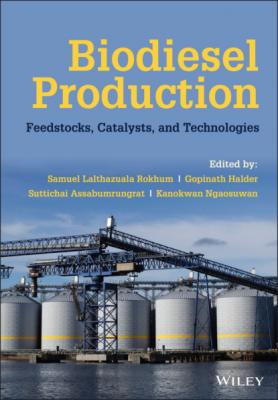ТОП просматриваемых книг сайта:
Biodiesel Production. Группа авторов
Читать онлайн.Название Biodiesel Production
Год выпуска 0
isbn 9781119771357
Автор произведения Группа авторов
Издательство John Wiley & Sons Limited
| Edible oils | Nonedible oils | Animal fats | Other sources |
|---|---|---|---|
| Sunflower | Tobacco seed | Poultry fat | Switchgrass |
| Soybean | Rubber seed | Pork lard | Spent coffee grounds |
| Sesame | Neem | Fish oil | Poplar |
| Safflower | Nag champa | Chicken fat | Olive stones |
| Rice bran | Mahua | Beef tallow | Miscanthus |
| Rapeseed | Krating oil | Microalgae | |
| Peanut | Karanja | Fungi | |
| Palm | Jojoba | Cyanobacteria | |
| Mustard | Jatropha curcas | Calophyllum inophyllum | |
| Groundnut | Croton megalocarpus | ||
| Corn | Cotton seed | ||
| Coconut | Castor | ||
| Canola | Camelina sativa | ||
| Barley |
The earliest oil crops used for fuel synthesis have been designated as the first‐generation feedstock. Including mostly edible oils such as palm, rapeseed, sunflower, soybean, etc. [7–10], these are easy to convert due to their simple fatty acid composition. However, growing concerns over food security inhibit the use of these oils in fuel synthesis.
With advantages ranging from being nonedible to having the potential of growing in harsh and arid climates as well as being useful as decorative plants, feedstock designated as second generation includes both these nonedible oil crops and waste oils or fats such as waste cooking oil (WCO), brown and yellow grease, and animal tallow. The fuel yield is analogous to that obtained from edible oilseeds and hence is a much better alternative, provided that the chosen feedstock is sufficiently available to sustain commercial scale production.
Using plant‐based oils usually means that the oil produced per kilogram biomass is far less lucrative in terms of net energy benefits. Also plants tend to have long growth cycles with typically one harvest per year, which is a setback in terms of annual oil yield and fuel production. This is where lipid accumulating microalgae, designated as third‐generation feedstock, are beneficial since (i) they do not need arable land [11]; (ii) algae show rapid growth rates and can accumulate biomass indefinitely without nutrient constraints [2]; (iii) they have high oil to biomass ratio; (iv) genetic manipulation on individual strains is easy; and (v) they can be engineered for high oil yield and for improved carbon capture and biomass accumulation. However, genetic modifications are often associated with very low success rates, and extensive screening is required. Also the culture medium must be properly aerated for CO2 solubilization, as well as to eliminate local accumulation of formed by‐products.
2.2 Importance of Valorization
Conversion of oils into esters and glycerol (or other glycerol‐free products) must be energy and cost efficient while being fairly controllable and adaptable with different oils. Transesterification (occasionally coupled with esterification) is the most widely sought approach because of its simplicity combined with versatility [6]. Mostly in conventional transesterification approaches, the use of catalysts is also an important factor both chemically (saving energy) and economically (reusability of heterogeneous catalysts compared with high reagent use in homogeneous systems). Catalyst preparation and/or use comes with added costs. It had been earlier established by Karmakar et al. [3] that feedstock procurement and refining can comprise up to 70% of the fuel price, and this goes up when uncommon nonedible oils are used, due to collection and processing. A simple way to overcome this is through the use of WCO, which are commonly available and can drastically cut down production costs [12]. Using waste biomass for catalyst synthesis is another step toward cost efficiency; however, that lies beyond the scope of the presented discussion.
In frying, the oils are used for multiple rounds (usually 8–10), and the process of reheating the oils past its smoke point results in thermal degradation of the glycerides and fatty acids, burning as well as inducing rancidity. The oils thus turn bitter and become unfit for further use, at which point they are discarded. Although small in quantity for each food outlet, the global scenario is quite insurmountable. According to the American Petroleum Institute, about 63.5 million barrels of WCO are discarded annually, whereas the average household needs only 0.063 barrels of this oil to produce enough electricity for a day [13]. Animal fats also contain very high amounts of free fatty acids (FFAs) and water, and thus cannot be transesterified without proper pretreatment [14].
2.3 Purification and Characterization
Purification to remove water, suspended solids, and FFAs is needed for optimal biodiesel synthesis from WCO. The glycerides in the oil are vulnerable to hydrolysis at elevated temperatures, which break these molecules into FFAs and glycerol [2]. Hence, the most common process of water removal is through drying in a hot air oven at 100 °C. During frying, polymerized oil and food residue are generated, which need filtration for removal. The repeated heating of the oil also results in breakdown of glycerides into FFAs, which can be esterified using acids.
The residual FFA in the product, which also affects its total acid number (TAN) must also be low to reduce its corrosiveness [15]. In order to determine TAN, m quantity of oil is dissolved in 2‐propanol along with phenolphthalein. Titration against KOH solution of N normality gives titer value t shown in Eqs. (2.1) and (2.2), where 56.1 = molar weight of KOH, 28.2 weight for 0.1 M oleic acid.

